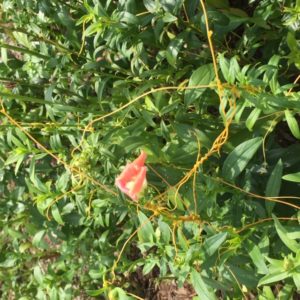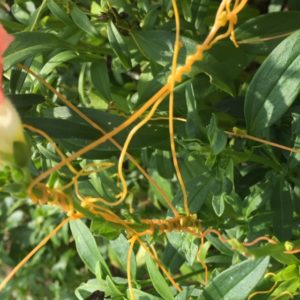Pest Alert – Dodder, a Parasitic Plant
go.ncsu.edu/readext?733846
en Español / em Português
El inglés es el idioma de control de esta página. En la medida en que haya algún conflicto entre la traducción al inglés y la traducción, el inglés prevalece.
Al hacer clic en el enlace de traducción se activa un servicio de traducción gratuito para convertir la página al español. Al igual que con cualquier traducción por Internet, la conversión no es sensible al contexto y puede que no traduzca el texto en su significado original. NC State Extension no garantiza la exactitud del texto traducido. Por favor, tenga en cuenta que algunas aplicaciones y/o servicios pueden no funcionar como se espera cuando se traducen.
Português
Inglês é o idioma de controle desta página. Na medida que haja algum conflito entre o texto original em Inglês e a tradução, o Inglês prevalece.
Ao clicar no link de tradução, um serviço gratuito de tradução será ativado para converter a página para o Português. Como em qualquer tradução pela internet, a conversão não é sensivel ao contexto e pode não ocorrer a tradução para o significado orginal. O serviço de Extensão da Carolina do Norte (NC State Extension) não garante a exatidão do texto traduzido. Por favor, observe que algumas funções ou serviços podem não funcionar como esperado após a tradução.
English
English is the controlling language of this page. To the extent there is any conflict between the English text and the translation, English controls.
Clicking on the translation link activates a free translation service to convert the page to Spanish. As with any Internet translation, the conversion is not context-sensitive and may not translate the text to its original meaning. NC State Extension does not guarantee the accuracy of the translated text. Please note that some applications and/or services may not function as expected when translated.
Collapse ▲Dodders are parasitic plants in the morning glory family. Dodders do not have chlorophyll and must obtain all of their nutrients, water, and carbohydrates by attaching themselves to other green plants. The strands drape themselves over the plant.
These plants have string-like vining stems that look to be leafless. They do have leaves but they are tiny scales. The flowers are small, bell-shaped, and range from yellow to white. They emerge in clusters from summer to fall. Each flower produces one to four seeds. Dodder produces small, pea-like fruit.

Control can be difficult.
Control on woody ornamentals in the home garden is to simply prune out the parasitized branches. In severe infestations, gardeners sometimes must remove the entire infected plants before dodder goes to seed.





